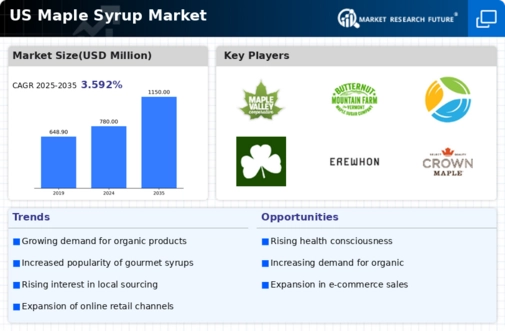Expansion of E-commerce Platforms
The maple syrup market is witnessing a significant transformation due to the expansion of e-commerce platforms. As online shopping continues to gain traction, consumers are increasingly turning to digital channels to purchase food products, including maple syrup. In 2025, online grocery sales in the US are projected to exceed $100 billion, indicating a substantial shift in consumer purchasing behavior. This trend presents an opportunity for maple syrup producers to reach a broader audience and enhance their market presence. By leveraging e-commerce, companies can offer a diverse range of products, including specialty and organic maple syrups, directly to consumers. Additionally, the convenience of online shopping may encourage more consumers to try maple syrup, thereby driving sales in the maple syrup market.
Rising Demand for Natural Sweeteners
The maple syrup market is experiencing a notable increase in demand for natural sweeteners as consumers become more health-conscious. This shift is driven by a growing awareness of the adverse effects of artificial sweeteners and refined sugars. In 2025, the market for natural sweeteners, including maple syrup, is projected to reach approximately $1.5 billion in the US. Maple syrup, being a natural product, is perceived as a healthier alternative, which is likely to boost its consumption. Furthermore, the trend towards clean label products, where consumers prefer items with minimal processing and recognizable ingredients, aligns well with the attributes of maple syrup. As a result, producers in the maple syrup market are likely to capitalize on this trend by emphasizing the natural and organic qualities of their products.
Increased Popularity of Gourmet Foods
The maple syrup market is benefiting from the rising popularity of gourmet foods among consumers. As culinary enthusiasts seek unique flavors and high-quality ingredients, maple syrup has emerged as a favored choice for enhancing various dishes. The gourmet food sector in the US is expected to grow at a CAGR of 5% through 2025, with maple syrup being a key ingredient in many gourmet recipes. This trend is further supported by the increasing number of food blogs and cooking shows that highlight the versatility of maple syrup in both sweet and savory dishes. Consequently, producers in the maple syrup market are likely to explore innovative product offerings, such as flavored syrups and gourmet blends, to cater to this growing consumer segment.
Innovations in Maple Syrup Production
The maple syrup market is poised for growth due to ongoing innovations in production techniques. Advances in technology, such as improved sap collection methods and enhanced processing techniques, are likely to increase efficiency and yield. For instance, the adoption of vacuum systems for sap collection can significantly boost production rates, potentially increasing output by up to 30%. Additionally, innovations in sustainability practices, such as using renewable energy sources in production, are becoming more prevalent. These advancements not only improve the overall quality of maple syrup but also align with consumer preferences for environmentally friendly products. As a result, producers in the maple syrup market are expected to invest in these technologies to enhance their competitiveness and meet the evolving demands of consumers.
Growing Interest in Local and Artisan Products
The maple syrup market is experiencing a surge in interest for local and artisan products as consumers increasingly prioritize supporting local economies. This trend is particularly pronounced in the food sector, where consumers are willing to pay a premium for products that are locally sourced and crafted. In 2025, the market for locally sourced food products is expected to grow by 10%, with maple syrup being a prominent category. This inclination towards local products not only fosters community support but also enhances the perceived quality and authenticity of the product. As a result, producers in the maple syrup market are likely to emphasize their local roots and artisanal production methods to attract consumers who value these attributes.


















Leave a Comment